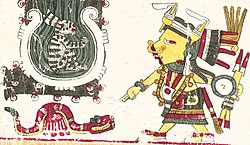
In Aztec mythology, Malinalxochitl, or Malīnalxōch, [1] ( Classical Nahuatl: Malīnalxōchitl [maliːnaɬˈʃoːtʃitɬ], from Nahuatl malinalli "grass" and xochitl "flower") was a sorceress and goddess of snakes, scorpions, and insects of the desert. [2] [3] She claimed the title Cihuacoatl, meaning "Woman Serpent" or "Snake Woman". [4] Her brother was Huītzilōpōchtli. [1] [2] [5] [6] During the migration, she was abandoned during her sleep by the Mexicas as directed by her brother. Afterward she had a son named Copil with Chimalcuauhtli, king of Malinalco. [3] [7]
- ^ a b Hyde & Clark (1993), p. 143
- ^ a b Heyden & Czitrom (1997), p. 37
- ^ a b Bahr (2004), p. 741
- ^ Hyde (1995), p. 258
- ^ Diel (2005), p. 96
- ^ Martín del Campo (2009), p. 122
- ^ Roskamp (2010), pp. 87–88
- Bahr, Donald M. (2004). "Temptation and Glory in One Pima and Two Aztec Mythologies". Journal of the Southwest. 46 (4): 705–761. ISSN 0894-8410. JSTOR 40170283.
- Diel, Lori Boornazian (2005). "Women and Political Power: The Inclusion and Exclusion of Noblewomen in Aztec Pictorial Histories". RES: Anthropology and Aesthetics (47): 96. ISSN 0277-1322. JSTOR 20167660.
- Heyden, Doris; Czitrom, Carolyn Baus (1997). "Los Insectos en el Arte Prehispanico". Artes de México (11): 37. ISSN 0300-4953. JSTOR 24326879.
- Hyde, Virginia; Clark, L.D. (1993). "The Sense of an Ending in "The Plumed Serpent"". The D.H. Lawrence Review. 25 (1/3): 143. ISSN 0011-4936. JSTOR 44235484.
- Hyde, Virginia (1995). "Kate and the Goddess: Subtexts in "The Plumed Serpent"". The D.H. Lawrence Review. 26 (1/3): 258. ISSN 0011-4936. JSTOR 44235550.
- Martín del Campo, Edgar (2009). "The Global Making of a Mexican Vampire: Mesoamerican, European, African, and Twentieth-Century Media Influences on the Teyollohcuani". History of Religions. 49 (2): 122. doi: 10.1086/649523. ISSN 0018-2710. JSTOR 10.1086/649523. S2CID 224808347.
- Roskamp, Hans (2010). "LOS NAHUAS DE TZINTZUNTZAN-HUITZITZILAN, MICHOACÁN. HISTORIA, MITO Y LEGITIMACIÓN DE UN SEÑORÍO PREHISPÁNICO". Journal de la Société des américanistes. 96 (1): 75–106. doi: 10.4000/jsa.11264. ISSN 0037-9174. JSTOR 24606437.

In Aztec mythology, Malinalxochitl, or Malīnalxōch, [1] ( Classical Nahuatl: Malīnalxōchitl [maliːnaɬˈʃoːtʃitɬ], from Nahuatl malinalli "grass" and xochitl "flower") was a sorceress and goddess of snakes, scorpions, and insects of the desert. [2] [3] She claimed the title Cihuacoatl, meaning "Woman Serpent" or "Snake Woman". [4] Her brother was Huītzilōpōchtli. [1] [2] [5] [6] During the migration, she was abandoned during her sleep by the Mexicas as directed by her brother. Afterward she had a son named Copil with Chimalcuauhtli, king of Malinalco. [3] [7]
- ^ a b Hyde & Clark (1993), p. 143
- ^ a b Heyden & Czitrom (1997), p. 37
- ^ a b Bahr (2004), p. 741
- ^ Hyde (1995), p. 258
- ^ Diel (2005), p. 96
- ^ Martín del Campo (2009), p. 122
- ^ Roskamp (2010), pp. 87–88
- Bahr, Donald M. (2004). "Temptation and Glory in One Pima and Two Aztec Mythologies". Journal of the Southwest. 46 (4): 705–761. ISSN 0894-8410. JSTOR 40170283.
- Diel, Lori Boornazian (2005). "Women and Political Power: The Inclusion and Exclusion of Noblewomen in Aztec Pictorial Histories". RES: Anthropology and Aesthetics (47): 96. ISSN 0277-1322. JSTOR 20167660.
- Heyden, Doris; Czitrom, Carolyn Baus (1997). "Los Insectos en el Arte Prehispanico". Artes de México (11): 37. ISSN 0300-4953. JSTOR 24326879.
- Hyde, Virginia; Clark, L.D. (1993). "The Sense of an Ending in "The Plumed Serpent"". The D.H. Lawrence Review. 25 (1/3): 143. ISSN 0011-4936. JSTOR 44235484.
- Hyde, Virginia (1995). "Kate and the Goddess: Subtexts in "The Plumed Serpent"". The D.H. Lawrence Review. 26 (1/3): 258. ISSN 0011-4936. JSTOR 44235550.
- Martín del Campo, Edgar (2009). "The Global Making of a Mexican Vampire: Mesoamerican, European, African, and Twentieth-Century Media Influences on the Teyollohcuani". History of Religions. 49 (2): 122. doi: 10.1086/649523. ISSN 0018-2710. JSTOR 10.1086/649523. S2CID 224808347.
- Roskamp, Hans (2010). "LOS NAHUAS DE TZINTZUNTZAN-HUITZITZILAN, MICHOACÁN. HISTORIA, MITO Y LEGITIMACIÓN DE UN SEÑORÍO PREHISPÁNICO". Journal de la Société des américanistes. 96 (1): 75–106. doi: 10.4000/jsa.11264. ISSN 0037-9174. JSTOR 24606437.